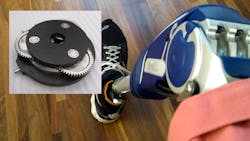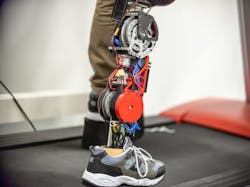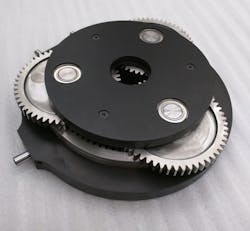Powerful Motors Give Prosthetic Legs a More Natural Gait
A team of biomedical researchers at the University of Michigan have developed a new type of prosthetic leg that is more energy efficient, quieter and gives users a more natural gait than other prosthetics on the market.
Using conventional prosthetics, which aren’t as compliant or free-swinging, patients must raise their hips to get their prosthetic foot off the floor, then swing the leg forward to take a step. This unnatural gait takes more energy than ordinary walking, puts more stress and pain on the hips and lower back, and eventually damages their natural joints. Robotic legs could provide more comfortable gaits, but one of their drawbacks is stiffness in the man-made joints.
The key to the success of the new prosthetic is its use of two small and powerful motors originally designed for a robotic arm on the International Space Station. The design offers a free-swinging knee and regenerative braking, which charges the battery with electricity generated when the foot hits the ground. This lets the prosthetic get almost a full day’s worth of walking from a single battery charge, twice what other powered leg prosthetics get.
“Our prosthetic leg consumes approximately half the battery power of state-of-art robotic legs, yet produces more force,” says Robert Gregg, an associate professor at the University of Michigan.
“We designed our joints to be as compliant, or flexible, as possible,” adds Toby Elery, a member of the team from the University of Texas UT Dallas. “Our robotic leg performs and even reacts like a human joint would, enabling a naturally free-swinging knee and shock absorption when contacting the ground.”
The new motors—one for the knee and the other for the ankle—are small and powerful and can fit in the small space available in a prosthetic leg. In the past, the small space available meant biomedical engineers were limited to using small motors that spun quickly but needed gearsets to get more torque out of the motor. Gears, unfortunately, are noisy, inefficient, add weight and make it harder for the joints to swing, making them stiffer.
The team’s stronger motors need fewer gears, which makes the joints more compliant and able to swing more freely, and they lower the noise level. The team estimates less complicated gearset takes the noise level down from that of a vacuum cleaner to a refrigerator. At the same time, regenerative braking absorbs some of the shock when the prosthetic foot hits the ground, making the act of walking less panful for the patient.
“If the joints are stiff or rigid, the force generated when the foot hits the ground is transferred to the residual limb, and that can be painful,” says Gregg. “Instead, we use that force to charge the battery.”
The amputees who tested the prosthetics said they could feel the leg helping them push off the ground as they walked. “In some cases, patients feel like muscles in their hips and back were working less with our leg, compared to their conventional leg,” Gregg says.
The team’s next step is to improve the control algorithms to let the leg automatically adjust to different terrains and paces, and transitions between different types of activity.


